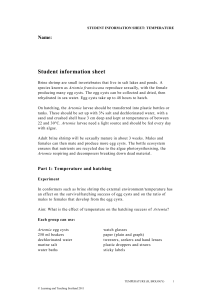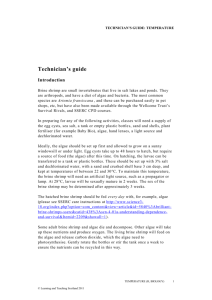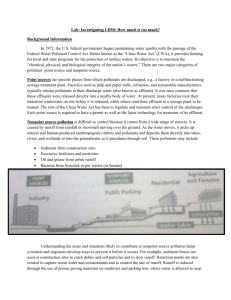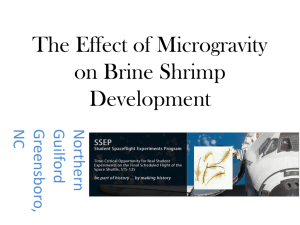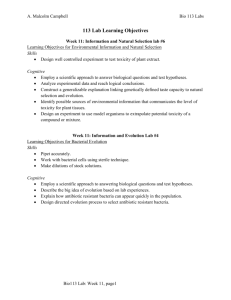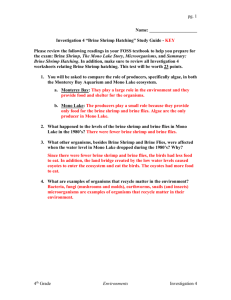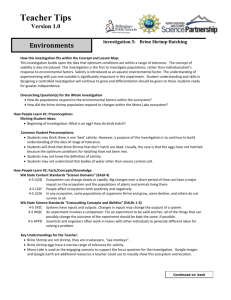Case Study First Draft: How does DNA replicate
advertisement
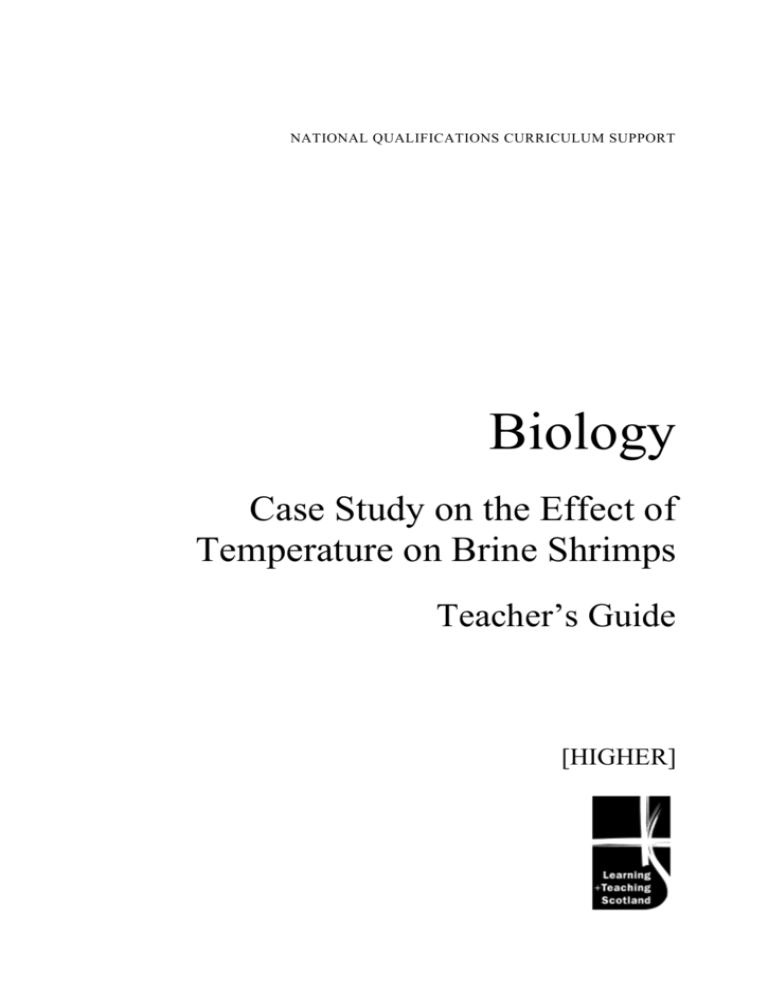
NATIONAL QUALIFICATIONS CURRICULUM SUPPORT Biology Case Study on the Effect of Temperature on Brine Shrimps Teacher’s Guide [HIGHER] The Scottish Qualifications Authority regularly reviews the arrangements for National Qualifications. Users of all NQ support materials, whether published by Learning and Teaching Scotland or others, are reminded that it is their responsibility to check that the support materials correspond to the requirements of the current arrangements. Acknowledgement Learning and Teaching Scotland gratefully acknowledges this contribution to the National Qualifications support programme for Biology. The publisher gratefully acknowledges permission to use the following sources: 24 hour photo of brine shrimps cysts hatching from stuck on Artemia by C Drewes, © C Drewes; illustration ‘Know your brine shrimp anatomy’ from http://britishecologicalsociety.org/documents/education/brine_shrimp_ecology.pdf, page 8 © Michael Dockery and Stephen Tomkins, British Ecological Society © Learning and Teaching Scotland 2011 This resource may be reproduced in whole or in part for educational purposes by educational establishments in Scotland provided that no profit accrues at any stage. 2 TEMPERATURE (H, BIOLOGY) © Learning and Teaching Scotland 2011 Contents Introduction 4 Part 1: The effect of temperature on hatching 5 Part 2: Research on temperature and development of Artemia 8 Costs and resources 8 TEMPERATURE (H, BIOLOGY) © Learning and Teaching Scotland 2011 3 TEMPERATURE Introduction Brine shrimp are small invertebrates that l ive in salt lakes and ponds. They are arthropods, and have a diet of algae and bacteria. The most common species are Artemia fransiscana , and these can be purchased easily in pet shops, etc, but have also been made available through the Wellcome Trust’s Survival Rivals and SSERC CPD courses. http://www.science318.org/index.php?option=com_content&view=article&id=5840:brilliant brine-shrimps-sserc&catid=438:scn-4-01a-understanding-dependence-andsurvival&Itemid=2209 In preparing for the following activities, classes will need a supply of the egg cysts, sea salt, a tank or empty plastic bottles, sand and shells, plant fertiliser (for example Baby Bio), algae and dechlorinated water. Ideally, the algae should be set up first and allowed to grow on a sunny windowsill or under light. Egg cysts take up to 48 hours to hatch, but require a source of food (the algae) after this time. On hatching, the larvae can be transferred to a tank or plastic bottles. These should be set up with 3% salt and dechlorinated water, with a sand and crushed shell base 3 cm deep and kept at temperatures of between 22 and 30°C. At 28°C, larvae will be sexually mature in 2 weeks. The sex of the brine shrimp may be determined after approximately 3 weeks. The brine shrimp should be fed every day with the algae (please see SSERC care instructions at http://www.science318.org/index.php?option=com_content&view=article&id=5840%3Abrilliant brine-shrimps-sserc&catid=438%3Ascn-4-01a-understanding-dependenceand-survival&Itemid=2209&showall=1). Some adult brine shrimp and algae die and decompose. Other algae will take up these nutrients and produce oxygen. The living brine shrimp will feed on the algae and release carbon dioxide, which the algae need to photosynthesise. Gently rotate the bottles or stir the tank once a week to ensure the nutrients can be recycled in this way. 4 TEMPERATURE (H, BIOLOGY) © Learning and Teaching Scotland 2011 TEMPERATURE The tank or bottles should be cleaned after a few months (please see SSERC care instructions at http://www.science318.org/index.php?option=com_content&view=article&id=5840%3Abrilliant brine-shrimps-sserc&catid=438%3Ascn-4-01a-understanding-dependenceand-survival&Itemid=2209&showall=1). During long holiday periods, or when a class is finished with a set of the shrimp, the water can be left to evaporate. To restart the population, add water again and the eggs will hatch once more. Sample results are provided to allow student data to be checked. Part 1: The effect of temperature on hatching Brine shrimp egg cysts can be incubated at different temperatures and the number of larvae that hatch can be counted for each temperature. Experiment Each temperature set-up requires: 100 cm 3 deionised water (tap water can be used but must be left out for 48 hours to dechlorinate) 3 g sea salt brine shrimp egg cysts beaker watch glass label stirrer thermometer tweezers seeker lamp hand lens. The class should be split into groups to investigate different temperatures. A 5°C beaker can be set up easily in the fridge, 20 °C is usually room temperature and then water baths can be set up at 25, 30, 35 and 40 °C. Each beaker should have 100 egg cysts added to it. The easiest way to do this is to put a small quantity of eggs onto a white sheet of paper. Dab some of the eggs onto a small, moistened piece of paper and count out 100 using a hand lens, seekers, etc. The paper can then be added to the beakers egg side down and the paper removed after a few minutes with tweezers. TEMPERATURE (H, BIOLOGY) © Learning and Teaching Scotland 2011 5 TEMPERATURE Larvae can be counted after 24–48 hours. After this time, larvae can be transferred to tanks or bottles. The experiment should be repeated to improve the reliability of results. Class data can be pooled and collated to show average results. This information should be displayed graphically in a suitable format. Identifying male and female brine shrimp If the Artemia are allowed to develop in tanks/bottles, then their sex can be identified after 2–3 weeks. Brine Shrimp Ecology (M. Dockery and S. Tomkins) from http://www.britishecologicalsociety.org/educational/brine_shrimp/index.php . Counting larvae When carrying out the experiment, students will need to check and count the number of larvae that hatch. To do this, cut the end off a large dropper (cut off the top 1 cm3 ) and use this to remove samples of the shrimp into small beakers. Hand lenses can be used to count the number of Artemia larvae. 6 TEMPERATURE (H, BIOLOGY) © Learning and Teaching Scotland 2011 TEMPERATURE Each temperature set-up requires: small beaker plastic dropper hand lens. Brine shrimp cysts hatching from ‘Stuck-on Artemia’ by C Drewes Lastly, once hatchlings have grown, students may wish to think about their developing brine shrimp in a fun way: http://www.youtube.com/watch?v=1Bx_JimGwM4&NR=1 (sea monkey dance) Further sources of information http://members.optusnet.com.au/chelmon/Brine.htm http://www.hometrainingtools.com/brine-shrimp-science-project/a/1225/ http://www.captain.at/Artemia/ Many websites give information on caring for brine shrimp, tips and hints, and some students may find examples like those below useful in researching feeding, care and maintenance, hatching times , etc: http://web.cecs.pdx.edu/~davidr/discus/articles/Artemia.html Download Brine Shrimp Ecology (M. Dockery and S. Tomkins) from http://www.britishecologicalsociety.org/educational/brine_shrimp/index.php . TEMPERATURE (H, BIOLOGY) © Learning and Teaching Scotland 2011 7 TEMPERATURE Part 2: Research on temperature and development of Artemia In the student information sheet, students are provided with current research on how temperature affects development time. Students are asked to draw conclusions, state variables that would need to remain constant, state how to improve reliability, etc. The final development of a brine shrimp is when its body has 17 segments. The second piece of information shows how the temperature affects the dry mass of the Artemia. Students are asked to find out why we use dry mass as a measurement, what this involves and their conclusion from the results. Costs and resources To complete either experiment within this case study most schools will find that they have all the equipment they need, as long as they have a free survival rivals Brine Date kit. These kits are still available if your school requires one. To get your free Survival Rivals kit go to http://www.philipharris.co.uk/survival -rivals-1/. In terms of other equipment, students will require empty plastic bottles, marine salt, sand and shells, dechlorinated water and a supply of food. If schools want to invest in an aerated system to keep any larvae and brine shrimp, a hatchery kit (£12.99, including eggs and salt) can be ordered from NTLabs, http://www.ntlabs.co.uk/product_details.php?product_id=72 . Schools may find that they need to replenish their supplies of Artemia eggs and or food. Egg cysts can be purchased from a number of sources: Artemia eggs from Aquatics online (£4.05) http://www.aquatics-online.co.uk/catalogue/brine-shrimp-eggs-andhatchers.asp#product622 egg cysts from Amazon (£1.99) http://www.amazon.co.uk/sera-Artemia-brine-shrimpeggs/dp/B001B5X0IC/ref=sr_1_2?ie=UTF8&s=garden&qid=1281637096& sr=8-2 8 TEMPERATURE (H, BIOLOGY) © Learning and Teaching Scotland 2011 TEMPERATURE Replacement algae can be ordered from various organisations, or shrimp can be fed alternative food such as: 25 g dried algae powder from Sciento (£5.85 , cat no ZK19) 50 ml Liquizell or Microzell/100 ml brine s hrimp food £4.99–£7.99 http://www.ntlabs.co.uk/product_details.php?product_id=70 There are whole kits available from both Philip Harris and Sciento containing salt, algae and egg cysts: the cheapest of these two options is a brine shrimp kit from Sciento (£22.60) http://www.sciento.co.uk/catalog/item/515/ Lastly, a replacement source of sea salt or Baby Bio may be necessary. Saxa rock salt can be purchased from large supermarkets, as can plant fertiliser. Timing There are elements of personalisation and choice within this case study and throughout Curriculum for Excellence. In terms of preparation, class contact time to discuss procedures and setting up, as well collecting results, this case study should take a minimum of three periods (for part 1). This does not include periods taken to look at secondary data or interpreting statistical information (part 2 will take approx. one period). Basic costs (with no free kit) – £12.00 (algae, egg cysts, salt and Baby Bio). Length of case study – 4 periods. TEMPERATURE (H, BIOLOGY) © Learning and Teaching Scotland 2011 9 TEMPERATURE Sample results Experiment – Temperature and hatching Temperature (°C) Number of Artemia eggs hatched 5 0 20 13 25 23 30* 49* (39) (32) (2) 35 12 40 0 *Repeated due to early death of brine shrimp . 10 TEMPERATURE (H, BIOLOGY) © Learning and Teaching Scotland 2011

